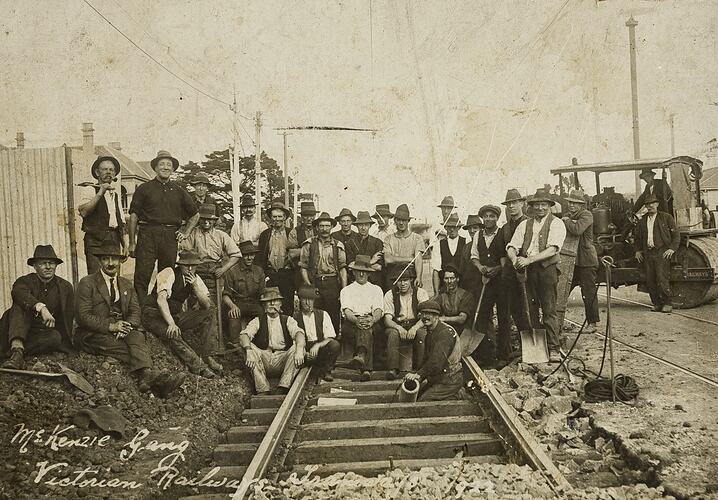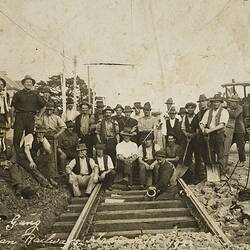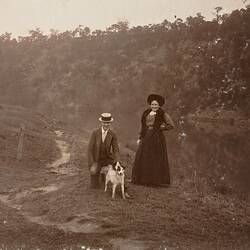Description of Content
A group of workers pose on partially constructed tracks of the Victorian Railways St Kilda to Brighton electric tramway, also known as an 'electric street railway'. McKenzie was the gang foreman or supervisor for the railways and these men worked under him. He is possibly the man wearing a tie and coat seated on the dirt pile on the left. As the St Kilda - Brighton tramway opened in 1906, this photograph appears to depict upgrading or maintenance work on the line. It shows a section of double tracks with slotted tramway style steel rails. The track on the left is being relaid with timber sleepers and ballast, which was presumably covered with compacted crushed rock or asphalt to form a hard road surface flush with to top of the rails. The contributor's father is the driver of the road roller shown in the background on the right. The roller appears to be a local design manufactured by A.H. McDonald & Co's Imperial Engine Works in Burnley Street, Richmond. Known as the W Type tandem roller this model was produced between 1918 and 1925, and was fitted with a petrol/kerosene engine, being one of the first internal-combustion powered road rollers available in Australia. The top of the radiator for the engine can be seen beneath the canopy in front of the driver. The roller has "VICTORIAN RAILWAYS" painted on the outer chassis rails indicating that it was owned by the Railways rather than a contractor. Much of the Victorian Railways construction work at this time was undertaken by directly employing 'day labour' rather than contractors. Behind the roller can be seen the standpipe of a sewer vent of the type installed by the Melbourne & Metropolitan Board of Works from the 1890s, when they began sewering Melbourne's inner suburbs.
More Information
-
Collection Names
-
Collecting Areas
-
Acquisition Information
Copied from Mr Frank Edwin Starkey, 01 Nov 2006
-
Place & Date Depicted
Brighton, Greater Melbourne, Victoria, Australia, 1922
Place Depicted Notes: Somewhere between Brighton and St Kilda. Source of Date Depicted: Inscription on image. -
Photographer
A Wright
Photographer Notes: Professional photographer. -
Individuals Identified
Starkey, Joseph Henry; other men's names unknown
-
Format
Digital file, TIFF, Black & White
-
Inscriptions
McKenzie Gang Victorian Railways - Tramways 1922
-
Classification
Rail transport, Railway infrastructure - permanent way, Construction workers
-
Category
-
Discipline
-
Type of item
-
References
[Book] Harrigan, L. J. 1962. The Victorian Railways to '62., pp.250-254 Pages
[Book] McDonald, Kenneth N. 1988. A.H. McDonald Industrial Pioneer., pp.36-46 & 129-134 Pages



